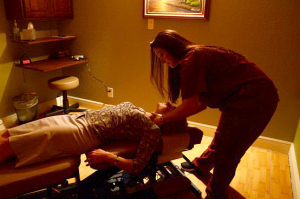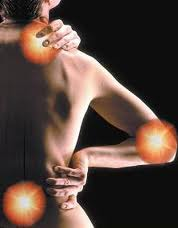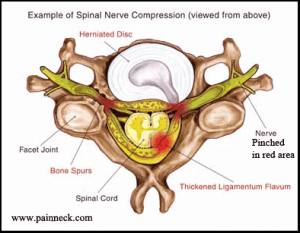 Nerves are like electrical cords that carry information from the brain to the rest of the body and vice-versa. They are distributed throughout the entire body. Motor nerves carry information from the brain out to the body. This allows the brain to send commands to the various organs of the body. For example, these commands are sent to the muscles causing them to contract and move, or sends information to the heart to either beat faster or slower. Sensory nerves send information from the body back to the brain for processing, including information about pain, touch, taste, temperature, or other sensations. The information travels along the nerve by an electrochemical signal, much like information traveling along an electrical cord. When a nerve is pinched, the signal is interrupted somewhere along its path.
Nerves are like electrical cords that carry information from the brain to the rest of the body and vice-versa. They are distributed throughout the entire body. Motor nerves carry information from the brain out to the body. This allows the brain to send commands to the various organs of the body. For example, these commands are sent to the muscles causing them to contract and move, or sends information to the heart to either beat faster or slower. Sensory nerves send information from the body back to the brain for processing, including information about pain, touch, taste, temperature, or other sensations. The information travels along the nerve by an electrochemical signal, much like information traveling along an electrical cord. When a nerve is pinched, the signal is interrupted somewhere along its path.
CAUSES:
A pinched nerve is caused when a nerve is somehow damaged or injured by direct pressure or compression and is unable to properly conduct its signal. There are many potential causes for a pinched nerve, depending on the location of the nerve. A pinched nerve in the neck or lower back can be caused by a herniated disc, arthritis, bone spurs, or spinal stenosis. A pinched nerve in the lower back or buttock can compress the sciatic nerve, which can cause sciatica. A pinched nerve in the wrist can be caused by carpal tunnel syndrome. Cubital tunnel syndrome is a similar condition caused by compression of the ulnar nerve in the elbow. Both of these conditions are more common in people with diabetes and people who perform repetitive activities such as a typist, using a computer keyboard for long periods of time, or assembly line workers. Swelling around a nerve can be caused by an injury, bruise, or other conditions, including the swelling of the extremities that can occur with pregnancy.
The symptoms of a pinched nerve depend on what nerve is affected. Each nerve is responsible for sending information to or from specific parts of the body. The most common symptoms of a pinched nerve are:
-
Pain
-
Numbness
-
Tingling (pins and needles)
-
Weakness of the muscles along the path of the nerve
A pinched nerve sensation may feel like, for example, the sensation when a part of your body has “fallen asleep.” It can cause symptoms at the site of damage, or any location further down the path from the affected nerve. In the neck a pinched nerve can cause neck pain or stiffness, along with symptoms down the arm. A pinched nerve in the lower back causes back pain and stiffness with symptoms down the leg. A doctor can often identify which nerve is pinched based on what area of the patient is effected.
When diagnosing a pinched nerve, the doctor will begin by asking the patient various questions about his or her pain, numbness, tingling, weakness, and other symptoms. The patient may also be asked about other medical conditions, work history, and family medical history. This information can often assist in identifying the nerve(s) affected. The doctor will then examine the part of the body involved. This may include testing the patient’s strength, sensation, and muscle tone in specific muscles. Depending on the results of the medical history and the physical examination, the patient may need additional tests. X-rays may be necessary to assess possible injury to the spine or arthritis of the spine. Depending on the severity and duration of the patient’s symptoms, he or she may also need a CT scan or an MRI scan. These imaging studies provide additional information about a pinched nerve not seen on regular X-rays.
In many cases a pinched nerve can be treated with rest and ice. If the pinched nerve is in the arm (carpal tunnel syndrome or cubital tunnel syndrome) the doctor may recommend a brace for a short period of time. The brace limits the amount of movement around the nerve, which allows it to rest and recover. The brace also prevents the patient from movements that may further compress or pinch the affected nerve. A brace used for carpal tunnel syndrome covers the wrist and and is extended slightly back. This is because during flexion (bending the wrist down) the median nerve in the wrist is further pinched. The brace for cubital tunnel syndrome in the elbow can be used to keep the elbow from bending too much which further stretches the ulnar nerve.
Physical therapy:
Physical therapy can assist to stretch and strengthen specific muscles in the body, which helps relieve the pressure on the pinched nerve.When the herniated disc ruptures and pushes out, the nerves may become pinched. A herniated disc may occur suddenly in an event such as a fall or an accident, or may occur gradually with repetitive straining of the spine. Often people who experience a herniated disc already have spinal stenosis, a problem that causes narrowing of the space around the spinal cord and spinal nerves. When a herniated disc occurs, the space for the nerves is further diminished, and irritation of the nerve results.
A pinched nerve can cause excruciating pain until it is properly treated. One of the most common causes behind complaints of neck pain, shoulder pain, and back pain; can be related to a pinched nerve. The term pinched nerve means that a nerve has been compressed or forcibly stretched in some fashion. If the nerve originates in the neck or back, the condition can have symptoms of tingling, burning or numbness in either the back of the neck or behind the shoulder and even into your arms, hands, legs or feet. This will also cause the muscles of the back to tighten in response, putting even more pressure on the nerves.
Realignment and Decompression:
When you visit the chiropractic doctor for a pinched nerve, you have two common options available for treatment. The first, realignment, involves the gentle and relaxing manipulation of the bones surrounding the spinal column and those found within the affected area. Your chiropractic doctor will gently move the bones and gently stretch muscles slowly and carefully, so that the pressure on the nerve will be eased.
Decompression is a non-surgical solution offered in some chiropractic offices as pinched nerve treatments. This involves a sophisticated multilevel table that gently stretches the spine to open up the space that the discs occupies and gets pressure off of compressed or pinched nerve.
Herniated Disc:
Pain that is thought to be the result of a pinched nerve might also be from a herniated disc. The bones that form the spine in a person’s back are actually cushioned by small discs that act like shock absorbers. As we age, these spongy discs may get drier and more brittle. Sudden trauma to the spine may cause these discs to bulge or break open. When this happens the bulging can cause nerves exiting the spine to become compressed.
A sign of a possible herniated disc may be weakness or numbness in both legs or both arms. Treatments include conservative chiropractic care starting with a complete examination to determine the correct diagnosis.
Subluxation:
A pinched nerve can also be the result of subluxation, a condition that occurs when a bone is partially pushed or pulled out of its usual position pressing on the nerve that is exiting the spinal cord. This is sometimes caused by trauma, like a direct blow to the joint affected, a fall, or car accident or work related accident. This can also happen to during everyday activities.
The chiropractic treatment for a subluxation usually involves adjusting the joints and bones by gentle relaxing movements of the joints by your chiropractor. Heat, electrical stimulation and ultrasound treatments are often used in conjunction with the manipulation to ease the stress to the ligaments, tendons, muscles, and cartilage that surround the joint.

Spinal Stenosis:
The narrowing of the spaces around your spinal cord causes this condition. When the space is reduced, the spinal nerve becomes compressed in a very painful way.
Spinal stenosis causes chronic lower back pain and can sometimes pinch the nerves that control muscle function and sensation in the legs. This is best treated through gentle relaxing manipulation or flexing of the spinal column.
Because each individual case is different, the appropriate chiropractic treatment is unique to each patient and is directed at the primary dysfunctions detected during the chiropractic exam. However, chiropractors commonly employ different treatments often including: gentle relaxing manipulation often followed by muscle relaxation and/or gentle stimulation and various exercises
The primary treatment for joint dysfunction, relaxing spinal manipulation involves the chiropractor gently moving the involved joint into the direction in which it is restricted. Also known as a chiropractic adjustment, spinal manipulation may involve the application of a short thrust in that direction. In many cases, instead of a thrust, a slow relaxing mobilizing movement is used. This can be done for any joint in the body.
Although their main method of treatment is the spinal manipulation, many chiropractic doctors also use other therapies to treat their patients. The following is a brief description of some of the most common therapies chiropractic doctors offer.
Muscle relaxation and/or stimulation consist of gentle stretches to the muscle that has excessive tension or repeated contractions of the muscle that is inhibited may also be used. If the muscle is very tight, a more vigorous stretch may be applied by the chiropractor. Gentle finger pressure techniques may be applied to trigger points to relieve the pain associated with the tight muscles.
Cryotherapy is also often used. Gel ice packs are wrapped in towels and applied to the affected area. This helps reduce swelling and pain and helps with pain control. These ice packs are often placed over massaging pads at the same time.
Chiropractic doctors commonly prescribe specific strengthening exercises for their patients with back, neck, and extremity problems. These exercises can decrease pain, prevent muscle deterioration, promote joint health, increase strength, stability and range of motion, and protect against new or recurring injuries.
Your chiropractic doctor will show you how to do the exercises and supervise you until you are comfortable doing them on your own. It’s important to keep up with your exercises as prescribed (similarly to drug prescriptions). Studies show that individuals who follow their exercise instructions heal faster than those who do not.
Following an injury, therapeutic stretching is an important way to prevent scar tissue from forming. Even after the injury has healed, maintaining a regular stretching program helps keep tissues flexible, increases mobility, and protects you from new injuries. As with exercise, your chiropractic doctor will instruct you on proper stretching techniques and will supervise you until you are comfortable enough to do them on your own.
Many chiropractic doctors use traction, in which traction devices are applied to distract specific areas of the spine. This treatment helps separate the vertebrae resulting in disc decompression, reduced nerve root pressure, and decreased pain. This can be done in the neck (cervical spine) or the low back (lumbar spine).

